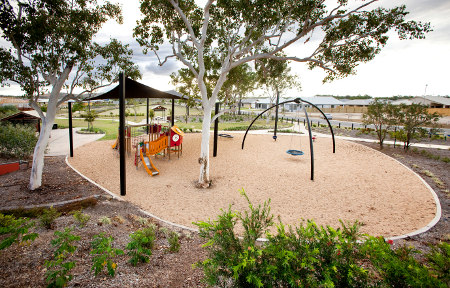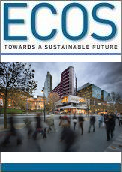
|
Published: 31 October 2011
‘The power of how’ – moving sustainability policy into practice
In 2010, the UN Global Compact sought the views of several hundred CEOs on issues of sustainability. Ninety-three per cent reported that addressing sustainability issues is critical to their future business success, and virtually all felt that sustainability should be fully integrated into business strategies and operations. Yet, most acknowledged there was a significant gap between their stated sustainability intentions and actual performance1.

|
|
A view across Burdell Park within Stockland’s North Shore community in Townsville. Credit:
Stockland
|
Arguably, this gap is understated, because the report also reveals a somewhat shallow appreciation of the full risks, implications and opportunities presented by sustainability issues.
While it’s true that many local and international organisations have well-articulated policies on sustainability, performance gaps emerge when efforts are made to translate these policies (with pervasive business implications) into practical actions, systems and investments.
Resolution of this gap between policy and practice is critically important for the individual organisations and society as a whole. While new companies sprout to take advantage of opportunities in the emerging green economy, society cannot afford the under-performance or loss of many existing small, medium and large organisations that represent the great bulk of economic activity, service provision and asset ownership.
Aspirations and policies can (and arguably should) lead practice, but organisations cannot afford for the policy–practice gap to endure. Otherwise, they risk serious credibility and reputational damage, as well as competitive disadvantage for customers, finance and staff.
For example, a recent study from Carbon Trust Advisory found that 50 per cent of multinational firms will select future suppliers in part on their carbon performance. According to the research, 29 per cent of suppliers are likely to lose their places on ‘green supply chains’ if they do not have an adequate performance records on carbon2. Organisations that wish to survive and thrive must make the transition to sustainable enterprises. Of course, the question is ‘how?’
Organisations that are engaging with this challenge, even in the face of the ongoing global financial turmoil, are realising that ‘how’ is not only the question, but also the answer – as the following examples show.
-
Stockland asked ‘How do we provide our customers with a better way to live?’ With their focus on community creation, sustainability and liveability, the company created the North Shore community in Townsville. They met high development standards while ensuring affordability and readiness of community services (e.g. shopping centres, recreational facilities, schools) from the outset, despite incurring a greater upfront cost. The value of the community infrastructure to residents was demonstrated by Stockland’s sales results: they achieved 30 per cent of the Townsville market share, with a 10 per cent premium over competitors3.
-
Goulburn Valley Water (GVW) asked ‘How can we transform a wastewater treatment plant from a liability into a sustainable asset?’ This inspired GVW and Greater Shepparton City Council to partner in a project to attract businesses that could transform GVW’s ‘wastes’ into resources. The result was an award winning eco-precinct situated within the buffer zone around GVW’s treatment plant which generates useful products and income for GVW and the region4.
-
Walmart asked ‘How do we create zero waste?’ This question triggered many solutions. One example was changing a single-serve yoghurt container to a four-pack, and reshaping the container to reduce packaging and take up less space. This saved resources, reduced fuel use in shipping (20 million gallons of diesel fuel annually), and cut transport emissions and waste (removing nearly 1700 tons of packaging from the supply chain each year). In turn, costs to Walmart and customers were reduced5.
It’s clear that in genuinely asking ‘how’, organisations find that sustainability presents benefits, not costs. Furthermore, the identified solutions often don’t require any new science or ‘green’ technology – just smarter use of existing technologies.
However, implementing those solutions does require new levels of collaboration across business units and supply chains, as well as better methods of option valuation and assessment. This is where behavioural sciences and economics come into play: building capability in collaborative problem solving and competencies to evaluate the whole-of-life benefits of different opportunities, with the goal of creating sustainable value.
For many organisations around the world, the reason to embrace sustainability thinking and practice is clear. How to do so is less apparent, and is their major current challenge. Those organisations that get on with it are gaining powerful insights and benefits. As always, the solutions we conceive are a function of the questions we ask. Organisations that aren’t timid or self-limiting, but genuinely and deliberately engaging with the sustainability challenge, are realising the power of ‘how’.
Dr Nick Fleming is Chief Sustainability Officer Sinclair Knight Merz, leading the application of sustainability thinking in business operations and client services. Through his Sustainable Enterprise column, Nick provides insight into how businesses and organisations are effectively putting sustainability theory into practice.
1 UNGC, Accenture (2010). A new era of sustainability, UN Global Compact?Accenture CEO Study 2010, London.
2 Dynamic Markets (2011). Cutting Carbon in the Value Chain, Carbon Trust Advisory, London.
3 Stockland (2011). Corporate Responsibility and Sustainability Report.
4 For more on the Goulburn Valley Water and Greater Shepparton City Council environmental partner project see http://www.gvwater.vic.gov.au/corporate/news/GVW_News_5-June-10_1188.asp
5 For information on Walmart’s progress on packaging see http://walmartstores.com/Sustainability/10601.aspx?p=9125



